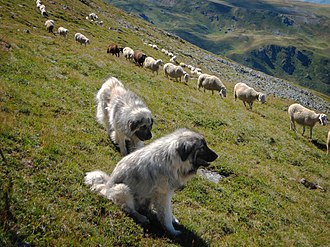
The domestication of vertebrates is the mutual relationship between vertebrate animals including birds and mammals, and the humans who have influence on their care and reproduction.[1]
Charles Darwin recognized a small number of traits that made domesticated species different from their wild ancestors. He was also the first to recognize the difference between conscious selective breeding (i.e. artificial selection) in which humans directly select for desirable traits, and unconscious selection where traits evolve as a by-product of natural selection or from selection on other traits.[2][3][4] There is a genetic difference between domestic and wild populations. There is also a genetic difference between the domestication traits that researchers believe to have been essential at the early stages of domestication, and the improvement traits that have appeared since the split between wild and domestic populations.[5][6][7] Domestication traits are generally fixed within all domesticates, and were selected during the initial episode of domestication of that animal or plant, whereas improvement traits are present only in a portion of domesticates, though they may be fixed in individual breeds or regional populations.[6][7][8]
Domestication should not be confused with taming. Taming is the conditioned behavioral modification of a wild-born animal when its natural avoidance of humans is reduced and it accepts the presence of humans, but domestication is the permanent genetic modification of a bred lineage that leads to an inherited predisposition toward humans.[9][10][11] Certain animal species, and certain individuals within those species, make better candidates for domestication than others because they exhibit certain behavioral characteristics: (1) the size and organization of their social structure; (2) the availability and the degree of selectivity in their choice of mates; (3) the ease and speed with which the parents bond with their young, and the maturity and mobility of the young at birth; (4) the degree of flexibility in diet and habitat tolerance; and (5) responses to humans and new environments, including flight responses and reactivity to external stimuli.[12]: Fig 1 [13][14][15]
It is proposed that there were three major pathways that most animal domesticates followed into domestication: (1) commensals, adapted to a human niche (e.g., dogs, cats, fowl, possibly pigs); (2) animals sought for food and other byproducts (e.g., sheep, goats, cattle, water buffalo, yak, pig, reindeer, llama, alpaca, and turkey); and (3) targeted animals for draft and nonfood resources (e.g., horse, donkey, camel).[7][12][16][17][18][19][20][21][22] The dog was the first to be domesticated,[23][24] and was established across Eurasia before the end of the Late Pleistocene era, well before cultivation and before the domestication of other animals.[23] Unlike other domestic species which were primarily selected for production-related traits, dogs were initially selected for their behaviors.[25][26] The archaeological and genetic data suggest that long-term bidirectional gene flow between wild and domestic stocks – including donkeys, horses, New and Old World camelids, goats, sheep, and pigs – was common.[7][17] One study has concluded that human selection for domestic traits likely counteracted the homogenizing effect of gene flow from wild boars into pigs and created domestication islands in the genome. The same process may also apply to other domesticated animals. Some of the most commonly domesticated animals are cats and dogs.[27][28]
- ^ Cite error: The named reference
zeder2015was invoked but never defined (see the help page). - ^ Cite error: The named reference
darwin1868was invoked but never defined (see the help page). - ^ Cite error: The named reference
diamond2007was invoked but never defined (see the help page). - ^ Cite error: The named reference
larson2014bwas invoked but never defined (see the help page). - ^ Cite error: The named reference
olsen2013was invoked but never defined (see the help page). - ^ a b Cite error: The named reference
doust2014was invoked but never defined (see the help page). - ^ a b c d Cite error: The named reference
larson2014was invoked but never defined (see the help page). - ^ Cite error: The named reference
meyer2013was invoked but never defined (see the help page). - ^ Cite error: The named reference
price2008was invoked but never defined (see the help page). - ^ Cite error: The named reference
macdonald2009was invoked but never defined (see the help page). - ^ Cite error: The named reference
diamond2012was invoked but never defined (see the help page). - ^ a b Cite error: The named reference
zeder2012was invoked but never defined (see the help page). - ^ Cite error: The named reference
hale1969was invoked but never defined (see the help page). - ^ Cite error: The named reference
price1984was invoked but never defined (see the help page). - ^ Cite error: The named reference
price2002was invoked but never defined (see the help page). - ^ Cite error: The named reference
frantz2015bwas invoked but never defined (see the help page). - ^ a b Cite error: The named reference
marshall2014was invoked but never defined (see the help page). - ^ Cite error: The named reference
blaustein2015was invoked but never defined (see the help page). - ^ Cite error: The named reference
telechea2015was invoked but never defined (see the help page). - ^ Cite error: The named reference
vahabi2015was invoked but never defined (see the help page). - ^ Cite error: The named reference
gepts2012was invoked but never defined (see the help page). - ^ Cite error: The named reference
pontarotti2015was invoked but never defined (see the help page). - ^ a b Cite error: The named reference
larson2012was invoked but never defined (see the help page). - ^ Cite error: The named reference
perri2016was invoked but never defined (see the help page). - ^ Cite error: The named reference
serpell2014was invoked but never defined (see the help page). - ^ Cite error: The named reference
cagan2016was invoked but never defined (see the help page). - ^ Cite error: The named reference
frantz2015was invoked but never defined (see the help page). - ^ Cite error: The named reference
pennisi2015was invoked but never defined (see the help page).